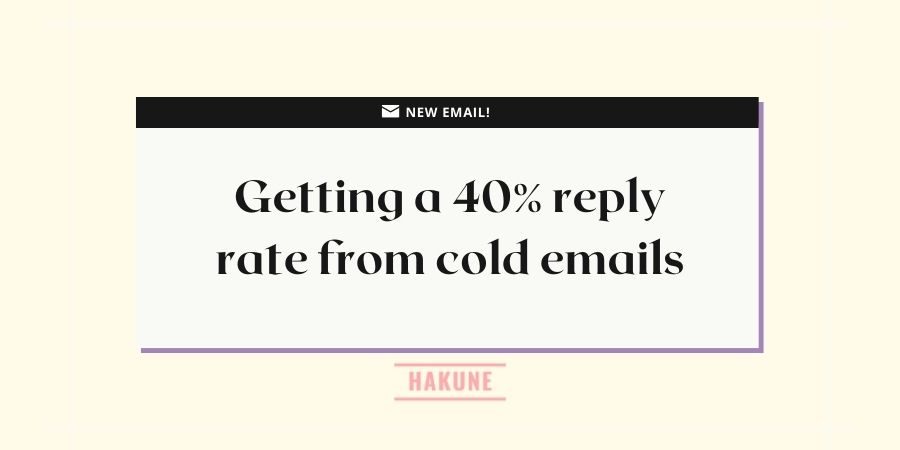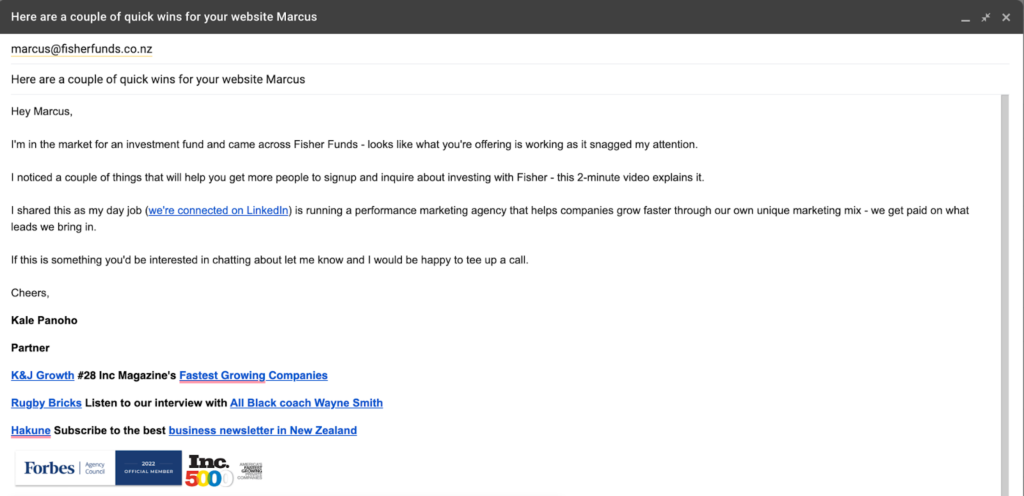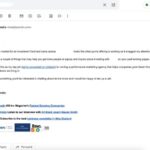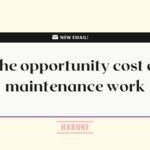The Method Episode #29
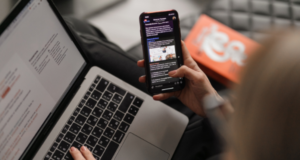
Cold Emails that Get a 40% reply rate
TL.DR: We’ve been testing personalised cold emails for the past week, and 40% of recipients are replying.
We haven’t practised cold emailing for a hot minute at K&J because our inbound game has been getting us more than enough work.
But with a downturn on the way, we thought we should test new ways to get clients so we have some backup options in case plan A fails.
One of those tests we’re running is cold emailing.
The industry standard reply rate for a cold email is 1% which isn’t very exciting and probably why we’ve left them alone for the past while.
So we’re pretty stoked with the 40% reply rate we’ve been getting.
Here’s how we’ve been killing it with cold emails.
1. Personalised subject line
2. Personalised email
3. Offer no strings attach valueMost make the cold email mistake of talking about themselves. Instead, you want to talk about how great the other person could be…. With your help, of course.This approach takes a little extra time upfront, but the 40x reply rate improvement is worth it on the back-end.
Key Takeaway:1. Cold outreach is way more effective when you personalise your approach and make it about them, not you.
2. To find new growth channels, you need to take many shots at goal. We didn’t know if this would work, and now we’ve found a significant new growth channel.

How To Stop Repeating The Same Mistakes
TL.DR – What I’m doing to stop making the same mistakes multiple times.
Nelson Mandela once said, “I never lose. I either win, or I learn.”
Apparently, this doesn’t apply to me. I’m constantly surprised by how many times I can make the same mistake without learning the lesson.
That’s an expensive bad habit when you’re running a business.
So about a year ago, I started recording my mistakes and subsequent lessons in a google note doc and collating them weekly in a repository on Roam Research.
Stuff like; ‘Do jobs that take less than 5 minutes now’ or ‘don’t give yourself room to negotiate‘ (regarding exercise).
To double-dip, I journal about these lessons at the end of my day too.
• I actually thought this was a pretty nutty thing to do and haven’t shared it till now. But last week, I watched an Alex Hormozi youtube vid describing how he does the same thing. So I guess I’m safe.
I read through these lessons about once a month and mentally note what mistakes I’m still making.
There are two things I’ve noticed from doing this.
• The longer I make a mistake, the more likely I will keep making it.
• The more I pay attention to my mistakes, the less likely I will keep making them.
Those quotes by Nelson Mandela and co might hold true if the mistake is painful enough, like crashing a plane (not fun). But for all the minor stuff, It’s easy to forget.
This method is by no means perfect but does seem to be helping.
Key Takeaway: If you want to make fewer mistakes, pay more attention to them.
“A fit body, a calm mind, a house full of love. These things cannot be bought — they must be earned.”
~ Naval Ravikant
Where We’re Learning
• Solving A 2 Million Ton Waste Problem-> How Amanda Buckingham (one of our readers) has persevered to create a product and company ridding the hair industry of aluminimum foil.
• The Top Idea In Your Mind -> Another gem from Paul Graham, explaining why you generally have one main priority at a time. He uses his experience with raising capital and investing in startups to explain.

Why Reducing Entropy Can Help During Downturns
TL.DR How to look for opportunities to grow in your business based on the 2nd law of thermodynamics.
The 2nd law of thermodynamics states that as energy is transferred or transformed, more and more of it is wasted. Otherwise known as entropy.
In good times it’s easy to ignore this waste in your business. When revenue and profit are up only, then who cares, right.
In the not-so-good times, this is a smart place to look for your next gains.
As the 2nd law states, there are two places to look in your business.
Transference
Where does money flow through your business? Where does information flow through your business? Where do resources flow through your business?
There will be waste and an opportunity to get more efficient at all these transference points – where something goes from point A to point B.
Transformations
Where does money turn into a product? Where does information turn into a decision? Where do resources combine into outputs?
Again wherever one thing becomes another in your business, there will be waste and an opportunity to get more efficient.
The cool thing about reducing entropy is that your rewards are immediate and obvious.
A saved cost immediately drops to your bottom line. A saved hour of work immediately gives you an extra hour of work to spend on other stuff.
Recessions don’t mean you have to lose; you just have to look for opportunities in different places.
Key Takeaway: Using and moving energy has a cost; reduce that cost to improve your business.
